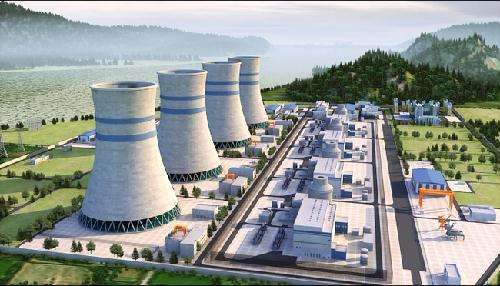核电所涉及的学科领域广泛,包含很多当今世界的高新技术,核电翻译人员需要阅读大量中英文资料,需要参与核电工程现场口译,积累核电翻译所需的技术知识。南京同传翻译公司作为中核集团、中广核集团、WANO东京中心的长期翻译服务供应商,拥有丰富的核电口译、核电资料翻译经验。
核电
Nuclear power
Nuclear power
自20世纪50年代起,人们就一直在利用核反应堆发电。2003年初时,世界上的30 个国家中共有441台核电机组在运行,总装机容量为359GW。
Nuclear reactors have been producing electricity since the 1950s and, in early 2003, there were 441 nuclear reactors operating in 30 countries with a total installed capacity of 359 GW.
核反应堆
Nuclear reactors
核反应堆的运行依赖于中子与燃料的原子核之间的核反应。铀作为几乎所有反应堆和铀-238。早期的反应堆使用天然铀作为燃料,它所包含的这两种同位素的质量百分组成分别为0.7%和99.3%。目前大多数正在运行的反应堆使用的是富集铀,它所包含的铀-235约占2.5%。
Nuclear reactors depend on a reaction between neutrons and the atomic nuclei of the fuel for their operation. Uranium the fuel for almost all reactors consists principally of two isotopes uranium-235 and uranium-238. In natural uranium, the fuel for early reactors, those isotopes are in the proportion of 0.7 per cent and 99.3 per cent, respectively, by weight. The enriched uranium used in most currently operating reactors contains about 2.5 per cent of uranium-235.
铀-235的原子核吸收中子并发生裂变时就释放能量。所谓裂变,就是铀-235的原子核分裂为两个携带着巨大能量的碎片(或称裂变产物),并伴随着释放几个高能中子(或称快中子)及一些Y射线。这些中子在反应堆中被减速,以便诱发铀-235进一步裂变。此类中子常被称作热中子,依靠热中子工作的反应堆被称为热中子反应堆。与铀-235不同的是,铀-238的原子核吸收快中子后,并不发生裂变而是变成铀-239,最终衰变为钚-239。钚-239吸收热中子后可以发生裂变,也可以俘获中子后形成其他的锕系元素,如镅或锔。目前正在考虑的一个问题是给某些反应堆供应混合氧化物燃料(记作MOX),它是富集铀和从乏燃料后处理中回收的钚的混合物。这被认为是使燃料回用和控制可用于制造核武器的钚的储量的一种好方法。
Energy is released when a uranium-235 nucleus absorbs a neutron and undergoes fission, that is, it splits into two large energetic fragments or fission products, accompanied by the release of several high energy or fast neutrons and some gamma radiation. The neutrons are slowed in the reactor so that they induce further fissions in the uranium-235. Such neutrons are often called thermal neutrons and the reactors that rely upon them thermal reactors. By contrast, when a nucleus of uranium-238 absorbs a fast neutron, it becomes uranium-239, which ultimately decays to form plutonium-239. This will also fission or capture neutrons to form isotopes of additional actinides, such as americium or curium. Consideration is currently being given to fuelling some reactors with mixed oxide fuel (known as MOX which contains enriched uranium mixed with plutonium recovered from spent fuel by reprocessing. This is seen as a way of recycling fuel and controlling stockpiles of plutonium that can be used to make nuclear weapons.
燃料在核反应堆中被组装成阵列状的堆芯。堆芯内还包含称作慢化剂的材料,通常为水或石墨,它能减缓中子的速度,或称作 使中子热化。燃料中由裂变产生的热量靠冷却剂(通常为水或气体)导出,然后让冷却剂通过热交换器以产生蒸汽,再由这些蒸汽 驱动汽轮机发电。
The fuel in a nuclear reactor is assembled in an array called the core which also contains the moderator, a material, generally water or graphite that slows or thermalizes the neutrons A coolant, usually water or gas, conducts heat away from the fuel and then passes through heat exchangers to make steam The steam then drives turbine generators to make electricity.
燃料密封于金属包壳中,堆芯被置于压力容器中(在某些设计中,燃料元件被装在单独的压力管中)。厚重的混凝土屏蔽有助于 吸收运行期间和运行之后堆芯发射的强烈辐射。多数反应堆还附加了一个密封的安全壳, 把反应堆以及热交换器围了起来。
The fuel is sealed in metal containers and the core is contained in a pressure vessel (or, in some designs, fuel elements are contained in separate pressure tubes). Massive concrete shielding helps to absorb the intense radiation emitted by the core during and after operation. Most reactors also have an additional containment building surrounding the reactors and usually the heat exchangers.
新燃料仅有轻微的放射性,不需屏蔽即可装卸。但是,一旦装入反应堆中,反应堆运行后其活度即大大增强,这主要是由于在燃料中产生了裂变产物。这意味着,反应堆一旦发生事故就有可能释放出大量的放射性物质。用过的燃料称作乏燃料,从反应堆中取出之后仍然还有余热,因此除了要加以屏 蔽以减少辐射照射外,还必须加以冷却以防止乏燃料熔化。
Fresh fuel is only mildly radioactive and can be handled without shielding Once in the reactor, however, there is an enormous increase of activity due mainly to the fission products that have been generated in the fuel; this means that an accident at the reactor could release significant amounts of radioactive material. After removal from the reactor the spent fuel remains hot and must be cooled to prevent melting, as well as shielded to reduce radiation exposure.
虽然对于所有的核电站而言安全都是至关紧要的,但自从发生了切尔诺贝利事故和苏联(USSR)解体以来,人们特别关注WWER 和RBMK这两种反应堆的安全性。在许多国际合作项目的支持下,由于东欧和前苏联专家们的努力,在提升这些反应堆的安全性方面已取得了很大的进展。
Although safety is a crucial issue for all nuclear power plants, there has been a particular focus since the Chernobyl accident and the breakup of the USSR on the safety of WWER and RBMK reactors Thanks to the efforts of specialists in eastern Europe and the former Soviet Union supported by many international cooperation projects, great progress has been made in upgrading the safety of these reactors.


 苏ICP备16061228
苏ICP备16061228